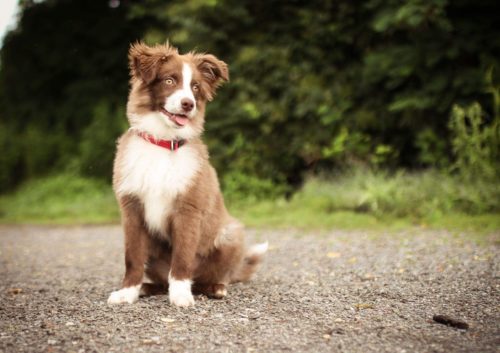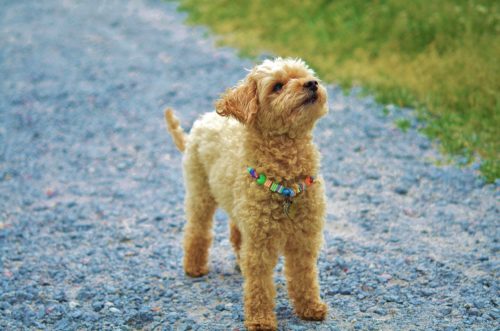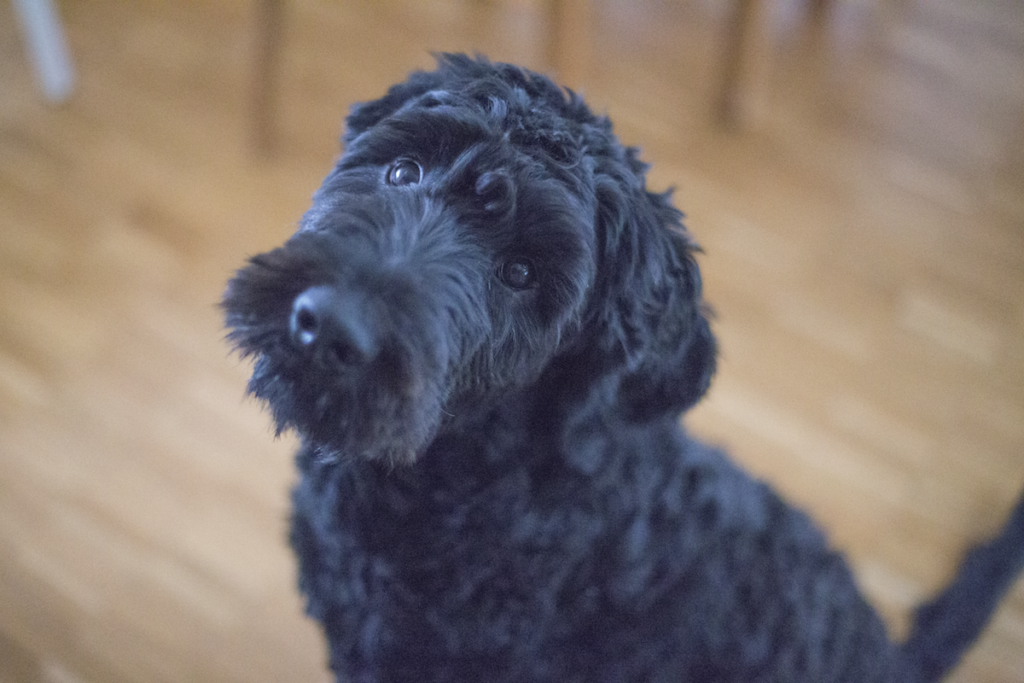As a dog owner, sometimes it can be difficult to distinguish between a behavioral phase or a medical condition that needs to be addressed. One example is if your dog is biting his tail. If your dog is chewing his tail, what are you supposed to do? It can be challenging to determine the right steps to take to find a solution to the issue due to the large amount of conflicting, and at times confusing, information available on the internet. To help you find a solution to this issue, here is a guide of what to do if your dog is biting its tail. The first step you will have to take is to identify the reason your dog is biting his tail, from there you will need to determine the right solution to make him stop biting his tail, and the final step is to implement the solution until the tail biting is corrected.
Why Is My Dog Biting His Tail
Before you can find a solution and correct the tail biting, you first need to understand why your dog is biting his tail. There are a number of different possible reasons why a dog will begin to bite his tail more than normal, and identifying the right reason will significantly increase the probability that the treatment will work and correct the tail biting. Finding the underlying cause of the tail biting may involve trial and error, and may require taking your dog to the veterinarian in some cases. Below are a handful of the most common reasons why a dog will begin to compulsively bite his tail.
Allergies
Many people do not know that dogs can have allergies just like human beings can. Dogs can have a range of allergies from food allergies to environmental allergies. If your dog is biting its tail, it may be because it is suffering from environmental or food allergies. Some of the most common environmental allergens include mold, pollen, or household chemicals. Dogs may also have a food allergy, with some dogs being allergic to poultry, wheat, potatoes, or even some types of vegetables. To test for this, your veterinarian can do an allergy test to see what environmental or food allergies your dog may be suffering from. Dogs can also be allergic to fleas, mites, or ticks, which can cause an inflammation of the skin (dermatitis) to develop.
Many dogs can be observed biting their tails if they are experiencing an allergic reaction to fleas, ticks, or mites. These allergic reactions are often worse when they are younger, with the most severe reactions typically presenting in dogs between three months and six years of age. Some dogs can also be allergic to products you use on them, such as shampoo. If they are allergic to what they are being bathed in, it can cause their skin to become inflamed, itchy, and irritated, leading them to chew at their tail to alleviate the discomfort.
Stress and Anxiety
Another condition that dogs experience is stress and anxiety. When some dogs begin to feel stressed or anxious, such as when their owner leaves for work, they may engage in destructive and repetitive behaviors in an attempt to soothe their own anxiousness. While many dogs funnel this stress into destructive behaviors in their environment, they may turn their anxiety inwards if they are confined to a crate. For some dogs, experiencing stress can manifest itself in a tail chewing behavior. Dogs that are not exercised frequently, do not engage in mentally stimulating activities or do not experience interactive play are more likely to exhibit stress of anxiety related behaviors like tail chewing. For some dogs, chewing their tail may be an attempt to get their owner’s attention.
Parasitic Infestations
A dog may chew his tail in reaction to a parasitic infestation. Fleas and ticks are a common affliction for dogs to experience, particularly during the warmer spring and summer months. Many dog owners are familiar with the way many dogs react to receiving a flea bite or a tick, they will scratch, lick, or chew at the spot to attempt to comfort themselves and rid themselves of the parasite. Many owners will have their dog take an oral medication, a medicated bath, or wear a medicated collar to prevent them from becoming infested with fleas or ticks.
However, some dogs are allergic to the saliva in the bites of fleas or ticks, making them much more affected by a flea or tick bite. Many dogs with flea allergies go undiagnosed and will chew and bite at the site of the allergic reaction to attempt to find relief. In addition, if a dog is suffering from a tapeworm, it can cause physical discomfort in the area around the anus that will make the dog try to gnaw or bite at their tail to rid themselves of the discomfort.
Hot Spots
A hot spot develops on the surface of a dog’s body when they repeatedly scratch, chew, or bite at an area of the skin until an open wound is created. Hot spots often form in environments where there is moisture and warmth. Because they often develop in warm and moist conditions, dogs are susceptible to developing secondary infections when bacteria is introduced to the wound before it can be properly treated. Hot spots on dogs are generally recognizable by matted hair, a lack of hair, the presence of blood or pus, the presence of scabs, or red, irritated skin. If your dog is biting their tail frequently, they may have formed a hot spot that is creating a reciprocal cycle of chewing as your dog attempts to comfort himself.
Impacted Anal Glands
Some dogs may bite or chew their tail due to an impacted anal gland. For a dog, its anal glands are extremely important both to their health and as a social tool by which they get to know other dogs and allow other dogs to know them. Human beings traditionally shake hands when they meet, but a dog will secrete fluid from its anal glands that other dogs will smell when they meet. This is why dogs will smell each other’s rear ends when they meet. In addition to tail biting, other signs that your dog may have impacted anal glands include constipation (difficulty defecating), a foul smell emitting from the rear end, or scooting (getting into a sitting position and dragging its butt across the ground). If the anal glands are severely impacted, the dog may begin to have pus or blood in their feces.
Injury
Some dogs may injure their behind and not alert their owner. If your dog has injured their hindquarters, they may begin chewing or biting at the affected area to draw attention to their injury. One example of an injury that can sometimes go unnoticed is if a dog fractures his tailbone.
Boredom
Just like human beings, some dogs develop unusual habits that they exhibit when they are bored. Many human beings will bite their nails when bored, shake their foot, or play with their hair. For a dog, these reactions to boredom can manifest themselves differently. Some dogs may obsessively bite or chew their tail when bored, a behavior that mimics what human beings know as obsessive-compulsive disorder. This can be harmful over time and some dogs may injure themselves from biting their own skin.
Hormonal Imbalances
In some dogs, a hormonal imbalance can lead to them biting their tail. If the dog’s body is not generating enough thyroid hormone naturally or if it is producing an excess amount of cortisol, the dog is at a higher risk to develop superficial skin infections. Some dogs may develop bald spots in the affected area and will bite and chew at the affected area to relieve their discomfort.
Determine the Right Solution for Your Dog
Once you have identified the reason why your dog is biting his tail, the next step is to determine the right solution to correct their behavior or treat the underlying issue. Finding the right solution will differ on a case by case basis, especially since there is a wide array of reasons why a dog may be biting their tail. It is important that you work in coordination with your veterinarian to make sure that you have determined the source of the behavior and are taking the proper steps to treat the problem. Below are a handful of possible treatment plans that may be implemented to help you stop your dog from biting its tail.
Changing Food
If your dog is biting their tail due to food allergies, the solution is to determine what foods are triggering the allergic reaction and then to eliminate them from your dog’s diet. Your veterinarian can do a food sensitivity or allergy test or determine the source of the allergic reaction and may recommend a special diet based on the results. Many pet owners are amazed at how quickly their dog’s behavior and skin changes when they switch to a diet that does not trigger any allergic responses.
Eliminating Parasites
If your dog is biting their tail due to parasites, it is vital that you treat the infestation. There are a multitude of flea and tick treatments available that you can try based on the recommendation of your veterinarian. If the tail biting behavior is in reaction to fleas, it is important that you wash all of your dog’s bedding, clean your house and furniture, and maintain a scheduled flea treatment to avoid reinfestation. If you have any other animals in the house with a dog infested with fleas, they will also need to be treated for having fleas.
Utilizing Medication
For a number of different underlying conditions, your veterinarian may recommend using medications to treat the issue. If your dog is suffering from dry, flaky skin that is causing them to itch, they may need a topical treatment or an oral medication to help their skin return to normal. If your dog is suffering from a hot spot, they may need a topical solution to help alleviate the itchiness and an antibiotic to prevent infection in the hot spot. If your dog is suffering from an allergic response or a skin infection, they may need antibiotics, steroids, or anti-itch products to help give them the relief they need to stop biting their tail.
Correcting and Preventing the Behavior
If your dog is exhibiting a compulsive behavior, such as tail biting, it is important that you intervene and take conscientious steps to help discourage them from exhibiting this behavior. This may mean using a bitter spray to discourage them from biting their tail or placing them in a collar that does not allow them to bite at hot spots or itchiness on their tail. It is vital that you use repetition to tell your dog “No” or “Leave it” when they are exhibiting a behavior that needs to stop. You can use positive reinforcement to encourage them to not bite their tail, such as if they stop on your command, you can give them their favorite toy as a reward.
Dealing with Boredom or Anxiety
Some dogs may act out because they are bored or anxious. In these cases, it is important to make sure that your dog receives enough exercise, mental stimulation, and affection. Destructive behaviors often decrease when all of your dog’s needs are being met. In addition, it is also important to train your dog to direct their chewing or biting to a place where it is allowed, such as biting toys or chewing on bones rather than on their tail.
Implementing the Solution
While treating a dog for biting their tail may not look the same for every dog, all solutions need to be implemented in a way that is consistent in order for them to be effective. If your dog is biting their tail out of boredom, you will need to work with your dog to find the right solution to keep them mentally and physically stimulated. No matter what solution you use with your dog, make sure you follow through until the behavior is corrected.
Sources:
- Peña, Melvin. “Tail Biting in Dogs – What Are the Causes?” Dogster, 1 Nov. 2018, Accessed 28 Feb. 2018. www.dogster.com/lifestyle/why-does-my-dog-keep-biting-her-tail-and-whining.
- Corrigan, Ryan. “Stop a Dog from Biting Its Tail.” WikiHow, 28 May 2018, Accessed 28 Feb. 2018. www.wikihow.pet/Stop-a-Dog-from-Biting-Its-Tail.
- “Tail Chasing – Does Your Dog Chase Their Tail?” Vetwest Animal Hospitals, 20 Apr. 2018, Accessed 28 Feb. 2018. www.vetwest.com.au/pet-library/tail-chasing-does-your-dog-chase-their-tail.
- “Compulsive Licking, Biting, and Scratching in Dogs.” WebMD, Accessed 28 Feb. 2018. www.pets.webmd.com/dogs/guide/dogs-and-compulsive-scratching-licking-and-chewing.
- Farricelli, Adrienne Janet. “How to Stop a Dog From Biting His Tail.” PetHelpful, 22 June 2018, Accessed 28 Feb. 2018. www.pethelpful.com/dogs/How-to-Stop-a-Dog-From-Biting-His-Tail.




